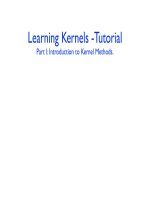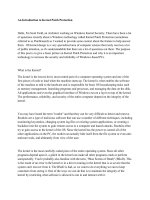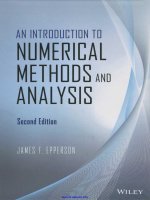introduction to kernel methods.
Bạn đang xem bản rút gọn của tài liệu. Xem và tải ngay bản đầy đủ của tài liệu tại đây (918.41 KB, 19 trang )
Learning Kernels -Tutorial
Part I: Introduction to Kernel Methods.
page
Outline
Part I: Introduction to kernel methods.
Part II: Learning kernel algorithms.
Part III: Theoretical guarantees.
Part IV: Software tools.
2
page
Binary Classification Problem
Training data: sample drawn i.i.d. from set
according to some distribution ,
Problem: find hypothesis in
(classifier) with small generalization error .
Linear classification:
•
Hypotheses based on hyperplanes.
•
Linear separation in high-dimensional space.
3
h :X �→{−1, +1}
H
S =((x
1
,y
1
), ,(x
m
,y
m
)) ∈ X ×{−1, +1}.
R
D
(h)
X ⊆ R
N
D
page
Linear Separation
Classifiers: .
4
H ={x �→sgn(w · x + b):w ∈ R
N
,b ∈ R}
w · x+b =0
w · x+b =0
page
Optimal Hyperplane: Max. Margin
Canonical hyperplane: and chosen such that for
closest points .
Margin: .
5
margin
(Vapnik and Chervonenkis, 1964)
w
b
ρ=min
x∈S
|w ·x +b|
�w�
=
1
�w�
w · x+b =+1
w · x+b = −1
w · x+b =0
|w ·x + b|=1
page
Optimization Problem
Constrained optimization:
Properties:
•
Convex optimization (strictly convex).
•
Unique solution for linearly separable sample.
6
min
w,b
1
2
�w�
2
subject to y
i
(w · x
i
+ b) ≥ 1,i∈ [1,m].
page
Support Vector Machines
Problem: data often not linearly separable in
practice. For any hyperplane, there exists such
that
Idea: relax constraints using slack variables
7
(Cortes and Vapnik, 1995)
x
i
y
i
[w · x
i
+ b] �≥ 1.
y
i
[w · x
i
+ b] ≥ 1 − ξ
i
.
ξ
i
≥ 0
page
Support vectors: points along the margin or outliers.
Soft margin:
Soft-Margin Hyperplanes
8
ξ
i
ξ
j
w · x+b =+1
w · x+b = −1
w · x+b =0
ρ =1/�w�.
page
Optimization Problem
Constrained optimization:
Properties:
•
trade-off parameter.
•
Convex optimization (strictly convex).
•
Unique solution.
9
min
w,b,ξ
1
2
�w�
2
+ C
m
�
i=1
ξ
i
subject to y
i
(w · x
i
+ b) ≥ 1 − ξ
i
∧ ξ
i
≥ 0,i∈ [1,m].
C ≥ 0
(Cortes and Vapnik, 1995)
page
Dual Optimization Problem
Constrained optimization:
Solution:
10
for any SV .
h(x)=sgn
m
i=1
α
i
y
i
(x
i
· x)+b
,
b = y
i
−
m
�
j=1
α
j
y
j
(x
j
· x
i
)
x
i
with
max
α
m
�
i=1
α
i
−
1
2
m
�
i,j=1
α
i
α
j
y
i
y
j
(x
i
· x
j
)
subject to: α
i
≥ 0 ∧
m
�
i=1
α
i
y
i
=0,i∈ [1,m].
page
Kernel Methods
Idea:
•
Define , called kernel, such that:
•
often interpreted as a similarity measure.
Benefits:
•
Efficiency: is often more efficient to compute
than and the dot product.
•
Flexibility: can be chosen arbitrarily so long as
the existence of is guaranteed (Mercer’s
condition).
11
Φ(x) · Φ(y)=K(x, y).
K : X × X → R
K
K
Φ
K
Φ
page
Example - Polynomial Kernels
Definition:
Example: for and ,
12
N =2
d =2
∀x, y ∈ R
N
,K(x, y)=(x · y + c)
d
,c>0.
K(x, y)=(x
1
y
1
+ x
2
y
2
+ c)
2
=
x
2
1
x
2
2
√
2 x
1
x
2
√
2cx
1
√
2cx
2
c
·
y
2
1
y
2
2
√
2 y
1
y
2
√
2cy
1
√
2cy
2
c
.
page
(1, 1, −
√
2, +
√
2, −
√
2, 1)
XOR Problem
Use second-degree polynomial kernel with :
x
1
x
2
(1, 1)
(-1, -1)
(-1, 1)
(1, -1)
√
2 x
1
x
2
√
2 x
1
Linearly non-separable
Linearly separable by
(1, 1, −
√
2, −
√
2, +
√
2, 1)
(1, 1, +
√
2, −
√
2, −
√
2, 1)
(1, 1, +
√
2, +
√
2, +
√
2, 1)
13
c =1
x
1
x
2
=0.
page
Other Standard PDS Kernels
Gaussian kernels:
Sigmoid Kernels:
14
K(x, y)=tanh(a(x · y)+b),a,b≥ 0.
K(x, y)=exp
−
||x − y||
2
2σ
2
,σ�=0.
page
Consequence: SVMs with PDS Kernels
Constrained optimization:
Solution:
15
with
for any with
0 <α
i
<C.
(Boser, Guyon, and Vapnik, 1992)
max
α
m
�
i=1
α
i
−
1
2
m
�
i,j=1
α
i
α
j
y
i
y
j
K(x
i
,x
j
)
subject to: 0 ≤ α
i
≤ C ∧
m
�
i=1
α
i
y
i
=0,i∈ [1,m].
h(x)=sgn
m
i=1
α
i
y
i
K(x
i
,x)+b
,
b = y
i
−
m
�
j=1
α
j
y
j
K(x
j
,x
i
)
x
i
page
SVMs with PDS Kernels
Constrained optimization:
Solution:
16
with
for any with
0 <α
i
<C.
x
i
b = y
i
− (α ◦ y)
�
Ke
i
h =sgn
m
i=1
α
i
y
i
K(x
i
, ·)+b
,
max
α
2 α
�
1 − α
�
Y
�
KYα
subject to: 0 ≤ α ≤ C ∧ α
�
y =0.
page
Regression Problem
Training data: sample drawn i.i.d. from set
according to some distribution ,
Loss function: a measure of closeness,
typically or for
some .
Problem: find hypothesis in with small
generalization error with respect to target
17
H
D
X
S =((x
1
,y
1
), ,(x
m
,y
m
))∈ X ×Y,
with is a measurable subset.
Y ⊆ R
L(y, y
�
)=(y
�
− y)
2
L(y, y
�
)=|y
�
−y|
p
p ≥ 1
f
R
D
(h)= E
x∼D
L
h(x),f(x)
.
h :X → R
L : Y ×Y → R
+
page
Kernel Ridge Regression
Optimization problem:
Solution:
18
or
max
α∈R
m
−α
�
(K + λI)α +2α
�
y.
max
α∈R
m
−λα
�
α +2α
�
y − α
�
Kα
with
α =(K + λI)
−1
y.
h(x)=
m
�
i=1
α
i
K(x
i
,x),
(Saunders et al., 1998)
page
Questions
How should the user choose the kernel?
•
problem similar to that of selecting features for
other learning algorithms.
•
poor choice learning made very difficult.
•
good choice even poor learners could
succeed.
The requirement from the user is thus critical.
•
can this requirement be lessened?
•
is a more automatic selection of features
possible?
19









